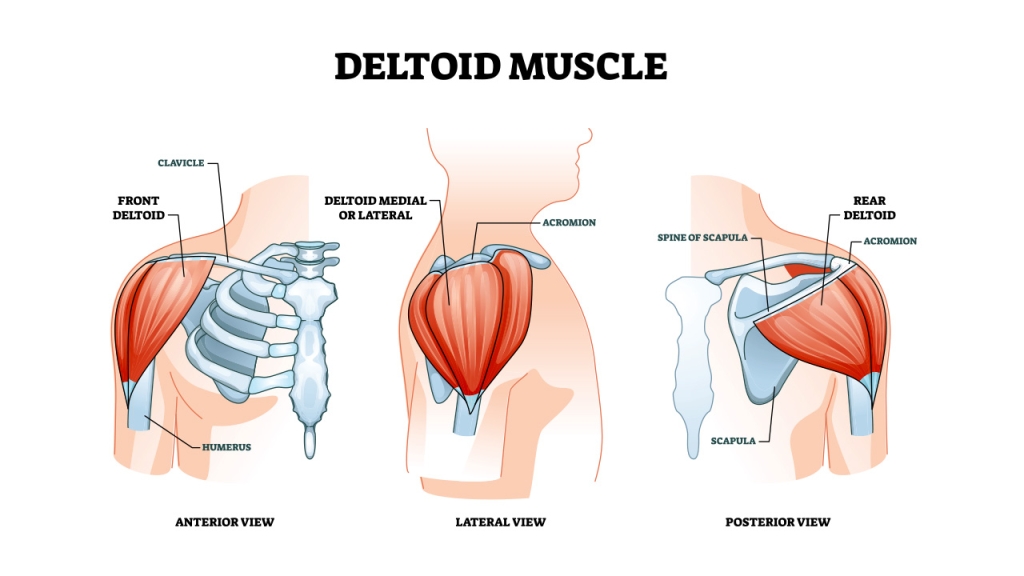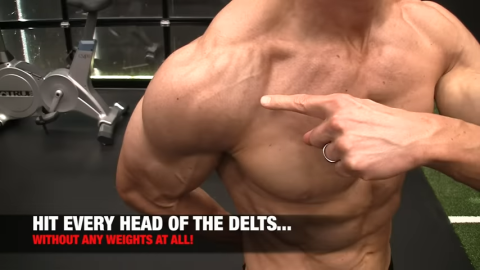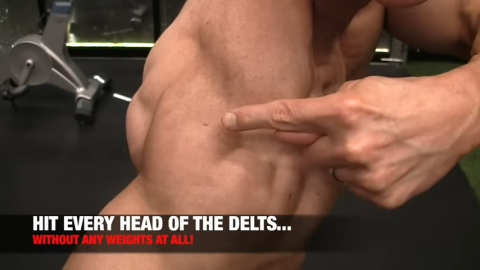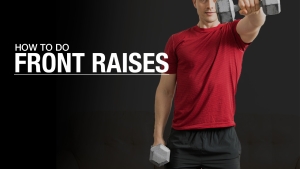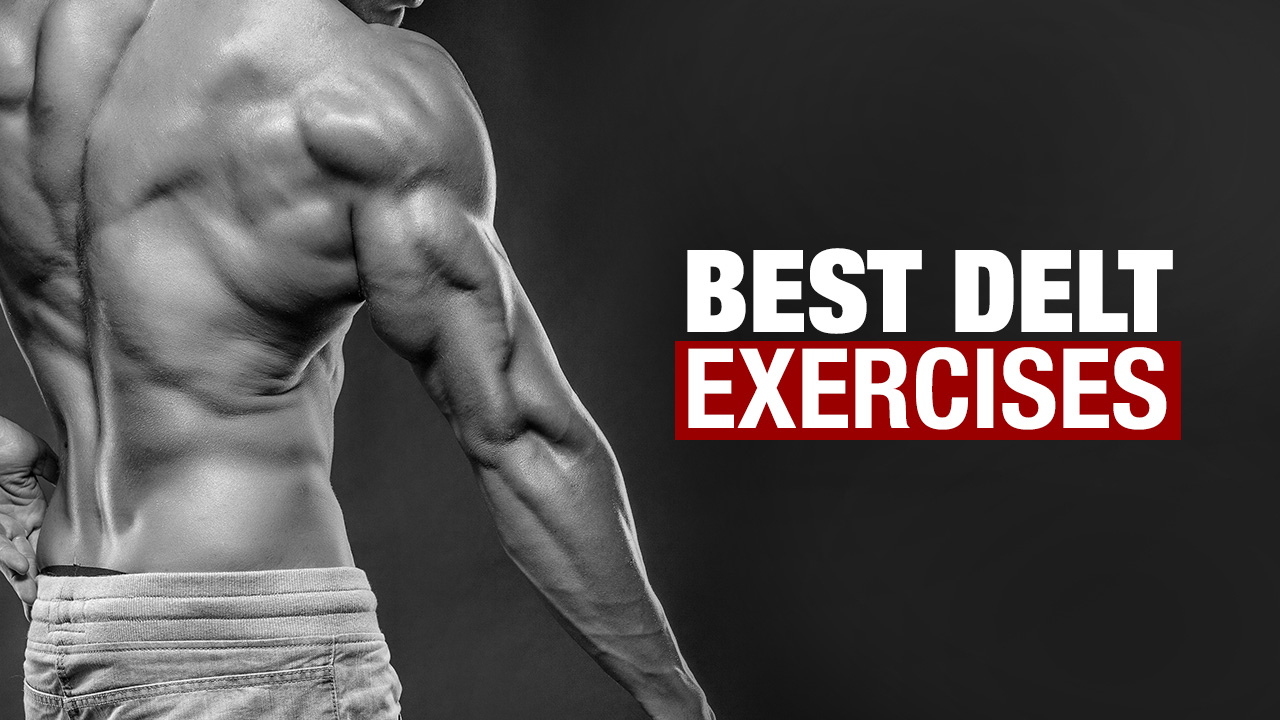
BEST DELT WORKOUT
The deltoid muscle is an important group of muscles located at the shoulder joints and plays a major role in our ability to perform daily activities.
Strengthening and improving the overall function of this important muscle group can provide several key benefits to the health of your shoulder, performance, and overall aesthetics.
Learning about delt exercises and incorporating them into your fitness routine can help you develop strong, balanced, and good-looking shoulders.
But if you want those kinds of shoulders, you need to know what’s involved in effective deltoid training. Hitting your shoulders involves more than performing some Overhead Presses and Lateral Raises.
If you want to see amazing results, you need to know where each deltoid muscle is and how you can best target it during a workout.
Lucky for you that you can think of this article like Deltoid Muscles 101.
I’ll cover what you need to know about what and where the delts are, how to target them, and how to maximize results.
ANATOMY OF THE DELTOID MUSCLE
Before I dive into the best delt exercises and how to perform them, I want you to understand the anatomy of the deltoid muscle.
I know I sound like a broken record but it’s important to understand and learn how to tap into the mind-to-muscle connection.
By knowing how to activate the mind-to-muscle connection, you can get the most out of your shoulder workouts.
The total deltoid is a major muscle group that is made up of three sections:
- Anterior deltoids
- Lateral deltoids
- Posterior deltoids
Here’s a closer look at each:
ANTERIOR DELTS (FRONT DELTS)
The anterior delts are located in the front of your shoulders and are mainly responsible for shoulder flexion. Shoulder flexion is when you bring your arm forward or across your body.
Many people mistakenly think that their chest day workout is enough to target the front delts and build cannonball shoulders. In reality, you’ll need to do some extra work. In fact, a shoulder day workout might not be a bad idea.
LATERAL DELTS (SIDE DELTS)
The lateral delts, also called the middle deltoid, are located in the middle of your shoulders. No upper body workout is complete without some attention here.
These muscle fibers play an important role in controlling rotation as well as abduction of the upper arm. Shoulder abduction is when you move your arm from a resting position out to the side.
These are the muscle fibers you want to focus on if you want to have that ‘broad shoulders’ look.
POSTERIOR DELTS (REAR DELTS)
The posterior delts, or rear deltoids, are located in the back of your shoulders and are mainly responsible for shoulder extension and external rotation. Shoulder extension is when you move your arm up behind you, while shoulder external rotation is when you rotate your arm outwards.
BENEFITS OF DELT WORKOUTS
Sure, there are other muscles that get more of the spotlight, but delt exercises shouldn’t be overlooked just because they are categorized as “secondary” in comparison to bigger muscles like the back and chest.
By incorporating delt exercises into your fitness routine, you can enjoy a number of benefits:
IMPROVED POSTURE
Focusing on improving each of the deltoid heads can help to keep the shoulders back and protect against developing poor posture. Healthy delts can help your posture by preventing rounded shoulders and excessive forward head posture.
IMPROVED MOBILITY
Well-trained deltoids help to improve the range of motion around your shoulder joint, which allows you to perform both exercises and everyday tasks with ease.
REDUCED RISK OF INJURY
Strong delts can help protect against injuries by providing more stability and support when lifting heavy objects or engaging in strenuous activities.
IMPROVEMENTS IN OTHER EXERCISES
When you dedicate time to improving the strength, shape, and health of your deltoids, you’ll start to notice that you perform other exercises such as pull-ups and presses more efficiently.
OVERALL BETTER AESTHETICS
Finally, defined deltoids can help to create an overall better-looking physique. It’s like when someone has big thighs but small calves. Something just seems off when you have a big chest but no shoulders.
Targeting your deltoids in your workouts is a great way to balance out your physique, increasing aesthetic appeal.
BEST ANTERIOR DELTOID EXERCISES
Now that we know the anatomy of the deltoid muscle and the benefits of delt workouts, let’s talk about some of the best deltoid exercises for each part of the muscle group.
We’ll start with the anterior delts:
FRONT DELT RAISE


HOW TO DO IT: For the starting position, sit on an incline bench that has been adjusted to a 30-degree angle incline from vertical. Grab a pair of dumbbells and perform a standard front raise by lifting the dumbbells straight up to shoulder height. Make sure you are using an overhand grip with the palms down towards the floor. You can also use a cable machine for this exercise. If you use one of these machines, be sure to properly set up the bench so that the front delt is placed into a position with a slight pre-stretch.
WHAT MAKES IT EFFECTIVE: Unlike the standing position, when you are leaned back on a bench in a 30-degree angle, you are placing a stretch on the front delt because the arm is in extension behind your body. When you bring the arm to shoulder height then slowly return to the starting position, you are getting a pre-stretch followed by a lot of tension.
CRUSH GRIP PRESS OUT


HOW TO DO IT: Stand with your feet hip-width apart and hold a dumbbell in each hand. With one foot slightly off the ground, slowly bend your hips and lower the weight toward the floor. Keep your back flat and chest up as you sink into the movement. When you reach full hamstring stretch, pause for two seconds before pushing up to starting position.
WHAT MAKES IT EFFECTIVE: You’re allowing your chest to contribute in a way that actually helps to take it out of the action while allowing the shoulders and the front delts, more specifically, to do the work.
BODYWEIGHT PUSH-AWAY


HOW TO DO IT: Get down on the floor in a plank position but put your weight on your hands, not your elbows. In fact, make sure your elbows are still staying in front of your body, positioned the same way as if you were pressing dumbbells, or a barbell over your head. With your feet hip width apart, press your body away, focusing the same force and tension in the delts. This will allow them to grow, regardless of whether you’re using bodyweight or external weights as your resistance. While the focus is on the deltoids here, be sure to keep the core tight throughout.
WHAT MAKES IT EFFECTIVE: Think of this like you are going to perform an overhead press. Except when you get down on the ground, you are no longer trying to press the bar away from your body. Rather, you are trying to press yourself away from the floor. But you still have the same, exact mechanics of this shoulder muscle activation.
BEST LATERAL DELTOID EXERCISES
Now that we’ve covered the best exercises for the front delts, let’s start to make our way around the muscle group.
Next up, we are going to focus on the lateral deltoids. As mentioned above, you’ll also hear this muscle group referred to as medial deltoid or middle delts.
DUMBBELL BUTTERFLY RAISE


HOW TO DO IT: In this exercise, you are allowing the positioning of our shoulders to help control the activation and transition from the front delt to the middle delt. And you’re doing so in a safe and controlled way. Start by holding a pair of dumbbells in an overhand position with the externally rotated arms, underhand positioning here, and raise the dumbbells up and out to the side so that your elbows are at shoulder level.
WHAT MAKES IT EFFECTIVE: You guys know how I feel about internal rotation when it comes to shoulders; however, with this exercise, you are taking your elevated arm and internally rotating the arm by going from an externally rotated position, back to neutral. In other words, you are not actually approaching internal rotation of the arm afe for those wit the top position. This makes it sath shoulder issues. Rather, you’re getting all the benefits of middle delt activation by having an internal rotation going on at the shoulder.
DUMBBELL HIP HUGGERS

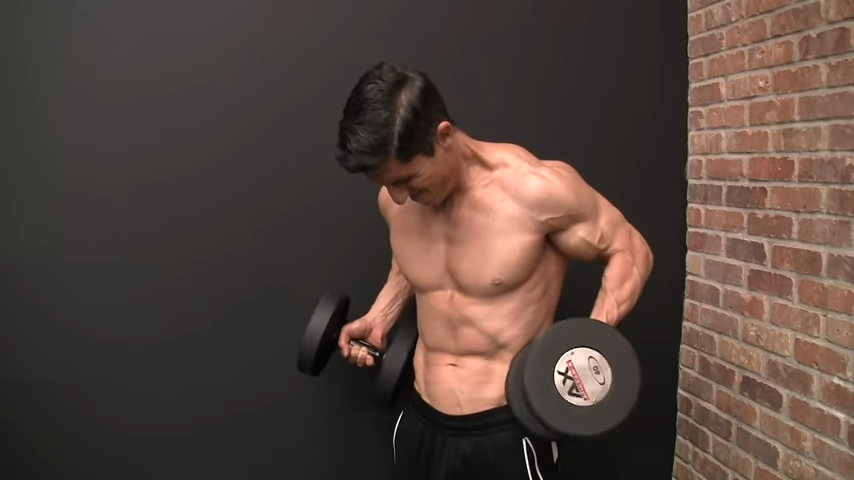
HOW TO DO IT: Hold a pair of dumbbells down at your sides. Keep in mind that this is not an Upright Row. This involves an externally rotated hand position as you come up. Stop around the level of the navel, or a little above.
WHAT MAKES IT EFFECTIVE: You’re getting the benefit in this position of having the abduction of the arm, in relation to the torso, but also the extension of the arm, back, behind the torso. This helps to also fire up that hard-to-hit rear delt.
BODYWEIGHT SIDE LATERAL RAISE


HOW TO DO IT: Rotate your torso on the fixed arm on the ground, getting that relative abduction of the arm in relation to the torso. This is a great exercise for serious delt activation and for those who don’t have access to a gym or weights.
WHAT MAKES IT EFFECTIVE: What you’re doing here is taking advantage of the concept of relative movement. Imagine you’re doing a Dumbbell Side Lateral Raise and your arm is raising out to the side. You can do the same shoulder movement by taking your arm, fixing it in position, and then moving your body away from it. In both instances, we have abduction of the arm, which we know is going to fire up that middle delt.
BEST POSTERIOR DELTOID EXERCISES
All right, guys, we are on the final stretch of the deltoid exercises, and we wrap up with the best exercises for the posterior deltoid.
Better known as rear delts, this is one part of the shoulders that I’m famously crazy about.
Focusing on the rear delts allows you to reduce your risk for injury by counterbalancing the tightness that builds up from our day-to-day routine.
If you are constantly typing or texting, there’s a good chance that your anterior delts are super tight and your posterior delts need some attention. Let’s get started!
UNDERHAND REAR DELT RAISE

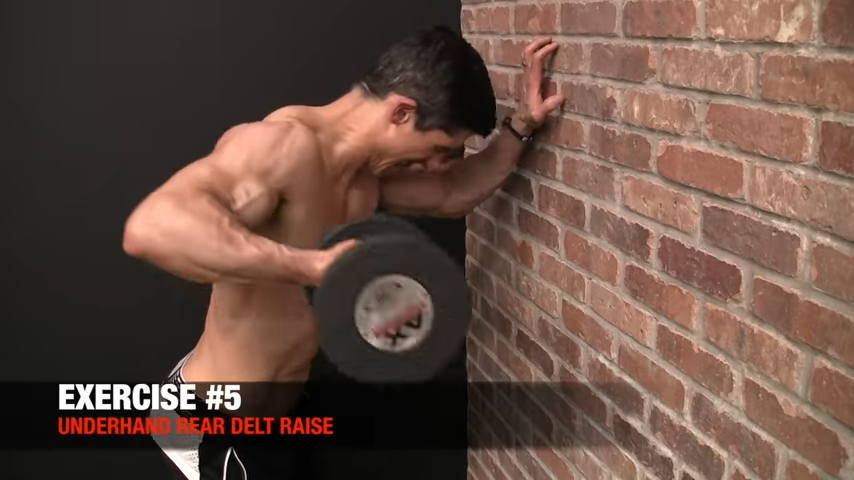
HOW TO DO IT: The traditional Reverse Fly is simply not going to hit the Rear Delt as well as you possibly can. However, this is an underhand dumbbell variation that is one of the best – and most underutilized ways – to hit the rear delts. The key, when you’re trying to activate your rear delt, is not going into this reverse fly motion here. What you really need to do is get into extension of the arm back, at the lowest position behind the body. Go into extension and get the upper arm further back. Then add one other component to it – external rotation – to go even further.
WHAT MAKES IT EFFECTIVE: The degree of contraction that you can feel is enormous from this movement. As a matter of fact, you don’t even need to put a dumbbell in your hand. If you take your hand right now, stand up, externally rotate, and pull up and back, you’ll feel that rear delt fire up like never before.
DUMBBELL SWIMMERS

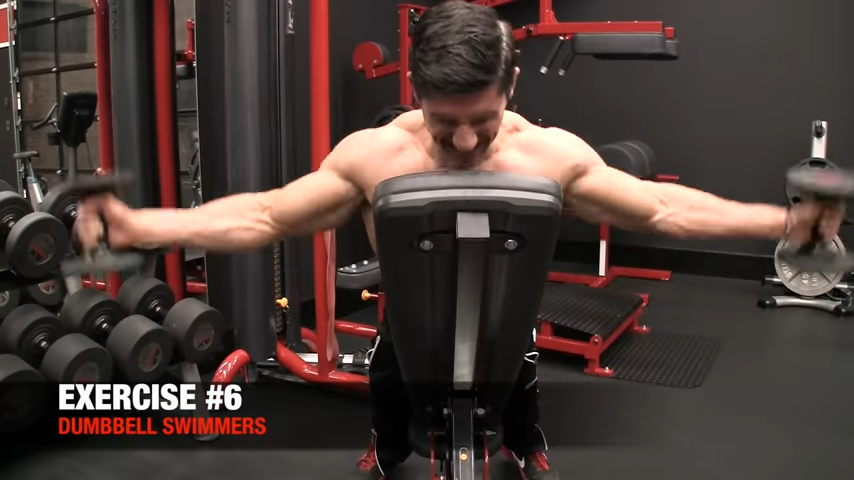
HOW TO DO IT: Raise your arms up and out to the sides. You’ll feel the middle delts are helping you do that. Now, swoop your arms forward to the front and eccentrically allow the front delts to get loaded up. Now, go back again and reload, and this ensures rear delt activation. We’re hitting all three heads and it doesn’t require really heavy weights to feel this. What’s more of a requirement is the activation and the contraction of the three heads of the delts, and you’re able to do it in one shot with this exercise.
WHAT MAKES IT EFFECTIVE: I know, at first glance, it probably looks like a rehab exercise. The fact is, you need to use lighter weights here. Maybe 5 or 10 pounds, at most. But what really matters is what is going on in the shoulders. There is a lot going on because by virtue of the path of the dumbbells here, you’re managing to hit all three heads of the delt in one move.
REVERSE IRON CROSS

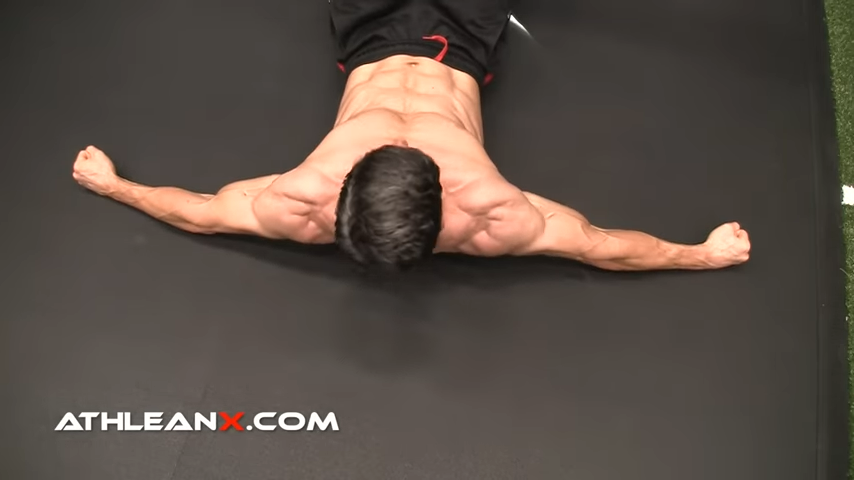
HOW TO DO IT: Get yourself on the ground and put your feet shoulder width apart on the ground. The goal is to try to do is push through your closed fists into the ground as hard as you can. A secondary goal is to push yourself high enough to get your elbows cleared from the ground.
WHAT MAKES IT EFFECTIVE: You can see the extreme action of the rear delts because we’re getting our body into extension. We’re getting our arms into extension back behind our bodies. The great thing here is that you can intensify this contraction by holding it for two or three seconds, and then lowering yourself back down.
There you have it, guys, the best exercises for each part of the deltoid muscle.
Be sure to incorporate one exercise for each area of the delts into your workout routine, and then in a month, come back to this article to try one of the others.
If you’re lacking a structured workout plan, we can help! Check out our ATHLEAN-X programs to see which is the best fit for your goals and fitness level.

- The deltoid muscle is made up of three sections: Anterior deltoids (front), lateral deltoids (side), and posterior deltoids (rear).
- Strengthening your delts can help to improve posture, mobility, performance, and aesthetics while reducing your risk for injury.
- To target the front delts, I recommend performing the following exercises: Front Delt Raise, Crush Grip Press Out, and Bodyweight Push-Away.
- If you want to hit your lateral deltoids, I recommend these delt exercises: Dumbbell Butterfly Raise, Dumbbell Hip Huggers, and Bodyweight Side Lateral Raise.
- Finally, Underhand Rear Delt Raise, Dumbbell Swimmers, and Reverse Iron Cross are great to target the rear delts.
- For each of these exercises, aim for 10-12 reps with good, solid form. If you start to burn out, take a quick 15-second rest then finish out the set. If your goal is to reach muscular fatigue, take at least a 30-second rest between sets.
- If your goal is building strength, a 3-12 rep range might work better depending on if you’re using heavy or light weight.

Jeff Cavaliere M.S.P.T, CSCS
Jeff Cavaliere is a Physical Therapist, Strength Coach and creator of the ATHLEAN-X Training Programs and ATHLEAN-Rx Supplements. He has a Masters in Physical Therapy (MSPT) and has worked as Head Physical Therapist for the New York Mets, as well as training many elite professional athletes in Major League Baseball, NFL, MMA and professional wrestling. His programs produce “next level” achievements in muscle size, strength and performance for professional athletes and anyone looking to build a muscular athletic physique.
















